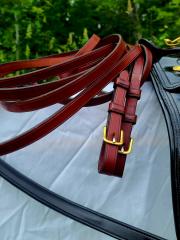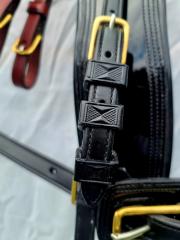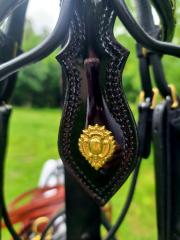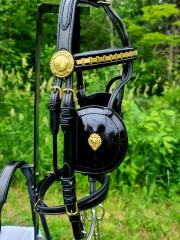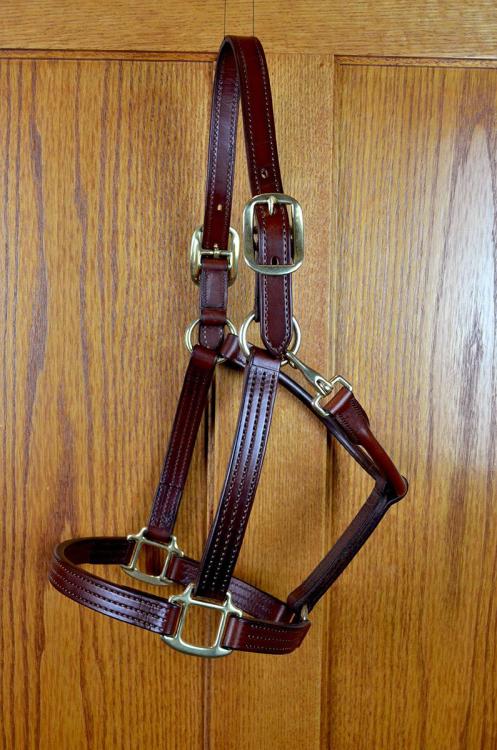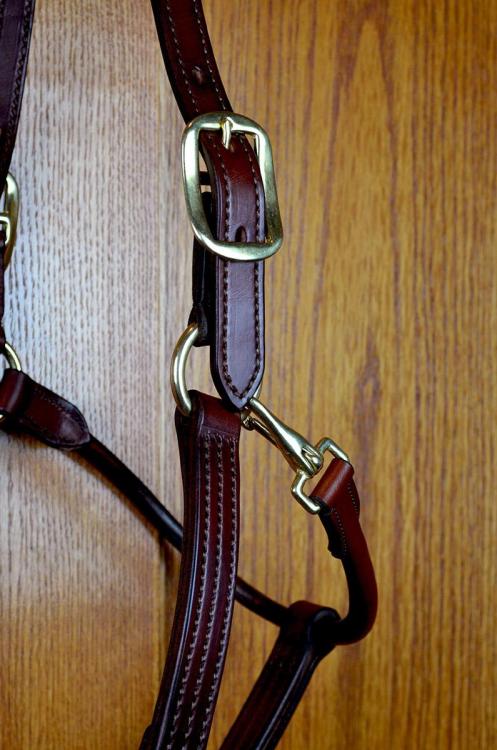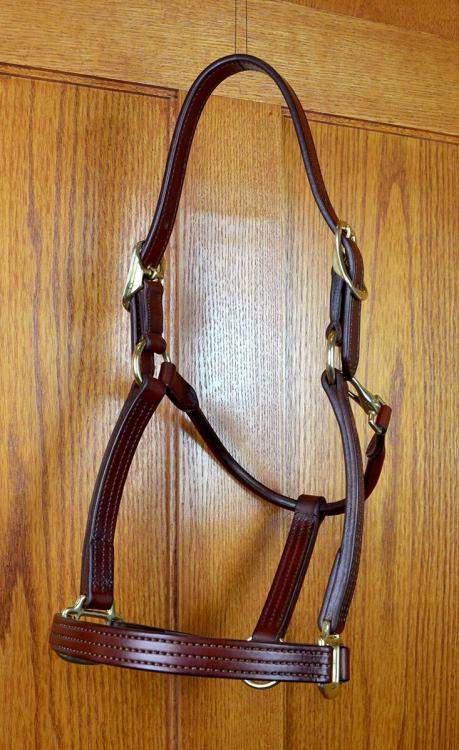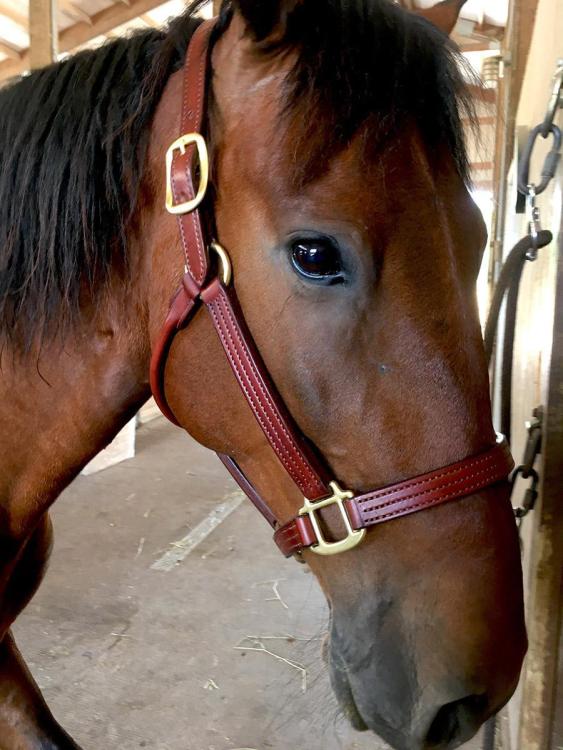-
Posts
1,284 -
Joined
-
Last visited
Content Type
Profiles
Forums
Events
Blogs
Gallery
Everything posted by TomE
-
Seems likely that the keeper is stretched out of shape or the stitching holes are torn out. I would make a new keeper and resew both sides of the buckle turn using the old holes. Need an awl to make holes in the keeper once it’s sandwiched between the layers of the turn. Angle the awl to sew the second side of the keeper. Here’s the method.
-
-
-
-
-
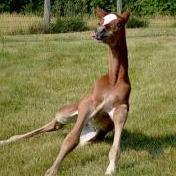
Looking for: High Quality Copper Rivet and Burr Setter.
TomE replied to SpruceMoose's topic in Leather Tools
It is common to have the burr showing but I've seen some folks like it reversed. Don't want the raised end of the rivet contacting the wearer, man or beast. -
I have old pair of Tandy Pro scissors (blue handles) with shallow serrations on the blades that I assume are there to grip the material. They produce smooth, straight cuts. I use them on 4-6 oz chrome tanned leather, and knives for most other leathers. Covering my plywood bench with HDPE was a big improvement for cutting with knives.
-

Looking for: High Quality Copper Rivet and Burr Setter.
TomE replied to SpruceMoose's topic in Leather Tools
I junked one from Tandy that is a loose fit on a #12 rivet and bends the burrs. I bought another from Springfield Leather that works fine. Like @chuck123wapati I use a small hammer to finish shaping the rivet after a couple of swipes with a file to flatten it. Those look very nice indeed. -
Not sure of a proper definition of artificial sinew, but Maine Thread Co sells twisted, waxed polyester cords that I believe they refer to as artificial sinew. I use these heavy cords for some saddle repairs.
-
A latigo knot would be a decorative way to secure the ends of the sling. It is used for the cinch strap of a western saddle. Starts with 3 holes in a triangular shape and a piece of latigo string. This video shows a fancy knot. A simpler version is to run the 2 ends through the top hole then secure the ends under the span between the 2 bottom holes.
-
Rediscovered an iSTOR Swiss sharpener among my stones and hones. https://www.istorsharpener.ch/instructions-for-use/instructions-for-standard-professional-sharpener/ I was surprised how nicely it put an edge on a dull hoof knife that was ready to go after stropping. Thinking about using it on some leather tools to re-profile the blade. Does anyone have experience with the iSTOR sharpener?
-

Cobra Class 14 Leather Splitter - Complete Unit vs. Head Only
TomE replied to PaulaK's topic in Leather Machinery
It is really handy to have both hands free to guide the leather or reverse directions. I think the motor and stand are very worthwhile. One aspect that might not be obvious is directing the split off the drive roller and out the back of the machine. Waxy leathers and softer temper leathers tend to get stuck in the slots and wrap around the roller. Controlling the drive speed with the foot pedal is another handy feature of the complete unit. -

What weight vegtan leather should I use for a sling seat?
TomE replied to mcbecklesworth's topic in How Do I Do That?
I can't see how the leather is attached to itself, and the construction method would influence my choice of weight. The leather in the pictures might not be the original seat and back? The seat would look nice made from one piece of leather with four flaps that fold around the frame and are sewn. If you're tooling the leather then veg tan is the obvious choice. Latigo is combination chrome tanned and veg tanned. It is strong but not so good for tooling. I'd be thinking about a single layer of 9-10 oz veg tan for the seat and might want to wet form the folds around the chair frame to make a neat job of it. You can waterproof it with a silicon oil (Fiebings Golden Mink Oil) or a clear acrylic finish. -
In "Making Harness" by Martin and Preston they list several suppliers of harness hardware: Aaron Martin, Beiler's Manufacturing and Supply, Chupp Blacksmith Shop, Harness Hardware Inc, Hillside Harness, and Weaver Leather Supply. Some of these are Amish businesses with no website and you'll have to search for a phone number. There is some info in the ShopTalk Magazine suppliers index https://shoptalk-magazine.com/suppliers/
-
I like Batz Corp heavy brass hardware. I download their catalog to see their products - never figured out their online search function. I buy stamped stainless bridle buckles from Weaver. Aaron Martin might be another source but I haven’t ordered from them.
-
Beautiful work and a very neat rifle. I use air rifles around the horses to discourage pigeons. They've come a long way since the Benjamin .177 pump I had as a boy.
-
I think the lead-up connects a harness breast collar to the breeching; however, I'm not too familiar with harness. Mentioned here https://smallfarmersjournal.com/walsh-no-buckle-harness/ and here https://upload.wikimedia.org/wikipedia/commons/8/80/The_harness_makers'_illustrated_manual._A_practical_guide_book_for_manufacturers_and_makers_of_harness%2C_pads%2C_gig_saddles%2C_etc._.._(IA_cu31924000022636).pdf Perhaps the term also applies to a piece of riding tack?
-
Barge cement thins nicely with Tanner's Bond cement thinner available at Tandy's. Barge all purpose thinner behaves similarly. I think both thinners contain toluene, heptane, and some ethyl acetate. Toluene is available in hardware stores. The other ingredients are harder to find.
-
A traditional saddler's edge dye is a mixture of dye and pearl glue/hide glue. Dye and burnish the edge in one step. Some folks use dye plus PVA glue (white Elmers glue). I think there are discussions about this on this forum. I use Pro Dye mixed 50:50 with Martins Edge Solution which does a good job slicking the edge of bridle leather. Another approach is to apply beeswax to the edge with a heated edge iron. The wax penetrates the leather. Need to buff thoroughly to remove excess wax.
-
Ha! I totally agree and stick to working from the ground with them. It also saves me embarrassment and them from wear and tear on their backs.
-
Please let me know how I can improve the document. Thanks for reading.
-
Thank you, Ron. Glad to be done with foaling season, and almost through breeding season so I can spend more time with leather. Thank you! I appreciate it. Thanks, I am a 3-trick pony: halters, bridles, and reins. I hand stitch bridles and reins (just the buckle and billets of reins). I machine stitch most of the halter, although the buckle straps and the hardware on the rolled throatlatch are hand stitched. There's a link to my halter methods in the post below. I buy sides of HO bridle leather and cut long straps from the back/butt of the hide then cut them to length as I go. Halters and especially bridles are made to measure and I've learned to fit them by studying commercial tack, and some trial-and-error refinements. The leather is dyed at the tannery and has a pasted or moss-back. I just dye the edges and any exposed skived parts like the points on a bridle. I've learned a great deal from the folks on this forum and am happy to share what I know.
-
Thanks! I appreciate it! Thank you kindly! The direction of the halter snap is debatable. In my experience, the outward facing snap will catch on hay nets and on woven wire fencing. We don't normally turn out horses with halters on, but we do use a few grazing muzzles with break away halters (leather crown piece on a nylon halter) for ponies. These inexpensive halters have an outward facing snap. I had a pony leave their broken break away halter clipped to the fence today (she was scratching an itch no doubt), and I just finished making a new crown piece for tomorrow's turn out. So, I think the outward facing halter snaps can be dangerous. A properly sized throatlatch is roomy, allowing 4 fingers to be inserted between the horse's jaw and the throatlatch. The snap should rarely touch the horse.
-
Triple stitched halter for Romeo, a PRE gelding. Hermann Oak bridle leather, brass hardware, and a rolled throatlatch. Happy birthday to his owner, Haley, my right hand gal at Maefield Farm.



